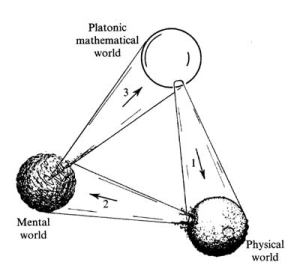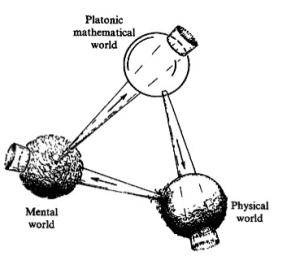A little more than a month ago, I was studying in the library and saw a rather big and conspicuous book on the shelf called The Book to Reality. I picked it up and started reading casually, but was soon absorbed in the content and fascinated by both the depth and breadth of the book. After a month, I am still reading the book. I haven’t gotten far (at all), but that’s not because the book is boring, but rather because of two reasons: 1) I am very ignorant about many topics discussed in the book (e.g. hyperbolic geometry), and 2) the book is so thought-provoking that I cannot get very far without stopping to think and write stuff in my notes, googling things etc.
For this post, I would like to go back to the first chapter and summarize and comment a little on a particularly thought-provoking section called “three worlds and three deep mysteries”.
In Penrose’s metaphysical framework, there are three forms of existence or “worlds”: the physical, the mental, and the Platonic mathematical, as illustrated in the figure below (extracted from p.18 of the book):
 Going clockwise, the figure reads (the three mysteries):
Going clockwise, the figure reads (the three mysteries):
- A small part of the Platonic mathematical is relevant to the physical.
- A small part of the physical induces the mental.
- A small part of the mental is concerned with the Platonic.
Going counterclockwise, the figure reads (Penrose’s three prejudices):
- The entire Platonic mathematical is within the scope of reason (in principle).
- The entire mental is dependent on the physical.
- The entire physical is governed by the Platonic.
However, since this view reflects some of Penrose’s prejudices, he has drawn another figure to accommodate different viewpoints:
 Going clockwise, this figure reads the same as before (the mysteries remain).
Going clockwise, this figure reads the same as before (the mysteries remain).
Going counterclockwise, however, this figure now allows:
- The possibility of mathematical truths inaccessible to reason (in principle)
- The possibility of mentality not rooted in physical structures
- The possibility of physical action beyond the scope of mathematical control
As indicated above, either view contains the same mysteries though; namely:
- Why do mathematical laws apply to the physical world with such precision? Why are mathematical laws so beautiful?
- How can some physical materials like human brains conjure up consciousness?
- How is it that we can perceive mathematical truth? How could we grasp the actual meanings of “zero”, “one”, “two”, “three”, etc.?
The book is mostly concerned with the first mystery: the remarkable relationship between mathematics and the physical world. Regarding the second mystery, that of consciousness, Penrose believes that “there is little chance that any deep understanding of the nature of the mind can come about without our first learning much more about the very basis of physical reality.” (p.21) The third mystery is discussed briefly in the book in relation to the notion of mathematical proof.
What do I think of this theory? Personally, I prefer the second figure, the one that allows the different possibilities. This is mainly because I think that there is a very small number of mental conditions not rooted physical structures (mystical experiences), and that there is also a very small number physical actions beyond the scope of mathematical control (miracles). I am not sure if there may be some mathematical truths that are simply beyond human reason, though.
Obviously, I believe in the existence of mystical experiences and of miracles due to my religion. However, this viewpoint is also surprisingly compatible with the concept of Tai Chi, more commonly known as Yin Yang. I am not an expert, but the idea is that everything in the world exists in a binary harmony in the form of Yin and Yang (also see Qur’an 51:49). In Yin (dark/feminine), there is always a little bit of Yang (bright/masculine), and in Yang, there is always little bit of Yin. If you want to cut the circle in half, there is always going to be some black and some white, never just one color. So, perhaps it is the case that the vast majority of mental conditions are rooted in physical structures, but there is a very small number that are not. And perhaps it is the case that the vast majority of physical actions are within the scope of reason, but there is a very small number that are not.
Although I prefer the second figure, I agree completely with Penrose’s identification of the three the mysteries associated with this framework.
The relationship between mathematics and physics is indeed mysterious and endlessly fascinating. The physical world conforms to mathematical laws to such a high degree that I sometimes suspect that the whole physical world is just the “image” of the mathematical world, and that the whole Platonic mathematical world could eventually be shown to be completely intertwined with the physical—two sides of the same coin kind of thing. But of course, this is a very idealistic conjecture.
Regarding the second mystery, it’s really what the whole field of Philosophy of Mind is concerned with. Explaining consciousness is the “hard problem”! And indeed I thought very hard about this problem when I was taking Philosophy of Mind more than three years ago. The conclusion I reached was the same as Penrose’s: we still don’t have enough understanding of the physical world to figure it out. Specifically, I came to agree with the philosopher David Chalmers on this issue (Type F Monism).
The third mystery is not formulated very clearly in my mind, but I suppose that it’s related to epistemological questions like these: How do we know what we know? What exactly is the connection between the mental world and the Platonic mathematical world? Is logic everything? This is a very deep mystery, and in my mind perhaps the most difficult one to solve.
An additional thought: It seems that right now, we have the most chance solving the first mystery, and that in order to solve the second and the third mysteries, we still need many more big ideas and big discoveries. I just have a feeling that these mysteries are so deep that we probably still don’t know what we don’t know! (We have to account for the “unknown unknowns!) We can still think about these things to come up with the most plausible conjectures, though—an activity otherwise known as philosophy. Perhaps it’s futile to philosophize when we have so little knowledge, but I believe with the help of divine input (God’s Revelation) we can at least work out some theories about the “shadows” we are seeing.
Overall, I like Penrose’s metaphysical theory for its coherence and ease of understanding. At this stage of my life, I am concentrating on understanding the relationship between mathematics and the physical world, but I am really interested in the whole thing—how everything fits together. I will never reach that knowledge, because that Knowledge resides with God and the path towards God is infinite, as God is infinite. So I will just look up into that unseen mountain top and keep climbing, insha’Allah!

Pingback: My Reaction to the Continuum Hypothesis Story | A Student Forever
Pingback: #ScienceInternelle « Our mathematical universe « de Max Tegmark et l’idéalisme endossé ici | Autrement qu'être Mathesis uni∜ersalis Problema Universale Heidegger/Husserl être/conscience : plan vital-ontologique vs plan spirituel d'i
Pingback: La nutrición como medicina Antiinflamatoria para Condiciones Crónicas – De Paciente a Paciente
Interesting discussion. My own take on it here:
https://journeymanphilosopher.blogspot.com/2016/09/penroses-3-worlds-philosophy.html
I think the book is called Road to Reality